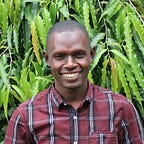Harvesting hope in South Sudan
How a WFP initiative is changing lives
A glance on his round face is met with a luminous and bright smile. His family is jovial and in high spirits. Peter Bareya, 27, and his family are rejoicing following a bumper harvest in their family farm. It is the first time in many years they have had a bountiful yield. What makes it even more special is that the country has had one of the worst drought episodes in history, but Peter and family, have defied the odds.
How they did it?
Peter is one of a 40-member farmer group in Beremaku One in Yambio, located about 355 km west of South Sudan’s capital, Juba.
Despite the best climatic conditions for agriculture in their area, Peter and his colleagues had given-up on commercial farming due to poor road networks, low crop yields and lack of market to sell their produce. Instead, they resorted to subsistence farming.
The result has been dire. Some 35 percent of the population in the Western part of Equatoria region are at crisis point in regard to their food security.
Subsistence no longer
Known as the Smallholder Agriculture Market Support (SAMS), and implemented jointly by WFP, Star Trust Organisation and a local bank, with support from Germany and Canada, the initiative aims at encouraging farmers such as Peter to grow more food.
The dream is to ultimately steer farmers away from low-input low-output subsistence agriculture to high yields both for consumption and for the market.
With technical support from WFP, the farmers established farmer groups in different villages in their area. They received training on post-harvest handling of cereals, best agronomic practice and environmental management. They were also trained in good agricultural methods to increase crop yields. They worked together to restore arable land to expand the area available for planting.
“Before this programme, we didn’t even know how to measure the size of the farm,” says James Bangayale, one of the members of the group. “Now we can calculate the yields we expect from our farmland.”
Each farmer opened three fields measuring 4,200 square meters each. Jointly the group has three fields totaling 12,600 square meters.
“Through this programme we have learned how to work as a team,” says James.“We are united and concerned about each other.”
The programme has changed farmers’ lives for the better. Most of their households are now food secure and they earn an income from the surplus crops.
For Peter, life is changing fast. He has expanded the area that he farms and more than doubled his income.
“I have bought a motorcycle to ease my transport from Yambio town to the farm,” says Peter. “I supply sweet bananas to the market and the money is helping me construct a five-bedroom house for my family.”
The father of five is also constructing a lodge in Yambio town. The developments he says are fueled by hard work and good business acumen. Peter is currently studying Business Administration at a local university in Yambio.
“I have been able to achieve these because I don’t smoke, I don’t drink and am good at saving,” he explains.
Farming as a business
The farmers have a ready market. In 2018 alone, WFP bought 500 metric tons of cereals for its school feeding and refugee programmes direct from small holder farmers, thereby injecting money into the local economy.
Some 5,000 smallholder farmers are benefiting from this initiative in different parts the country. Their joy about the initiative is evident. Naomi Fadul a 40-year-old mother of 12 is one of the happy farmers.
“We used to have one meal in a day, but now the quantity of food has increased,” says Naomi as she bends to uproot weed from her farmland. “Now my children can have all three meals.” She also explained how she can now afford to send her children to school.
Stopping food losses
Across Africa, smallholder farmers lose up to 30 percent of the crops harvested to disease, pests, rot — all caused by poor post-harvest handling and storage. By helping to prevent this through providing improved storage and packaging materials, WFP helps increase the availability of food.
With support from Netherlands and the European Union, WFP is also constructing and maintaining road networks to connect farmers to markets. This helps their produce not to go bad while in transit to markets. Since 2013, WFP has completed the construction and upgrade of more than 500 km of roads and built over 30 structures including culverts and bridges across South Sudan.
